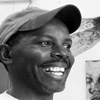Interview with John Beadle
John Beadle (born 1964, Nassau, The Bahamas) is one of the major Bahamian artists of the post-Independence generation. Born on the Island of New Providence in 1964, one of his earliest memories is of watching one of his grandfather’s landscape paintings, waiting for someone to walk into view. He went to the College of the Bahamas and studied under Stan Burnside, going on to the Rhode Island School of Design where he obtained a BFA in Painting. He studied in Rome, Italy and received his MFA from The Tyler School of Art, Temple University. In 1991 he was named Emerging Artist of Latin America and the Caribbean in Nagoya, Japan.
His work is in many private and corporate collections, including the National Collection of The Bahamas. Several of his series are about the despair of the illegal migrants who arrive by boat from Haiti, and he shows great dexterity in his use of different materials such as incorporating oars and machetes into his work. As well as exhibitions in the Bahamas, Beadle’s work has been shown in the United States, Germany, France, the Santo Domingo Biennale of Painting, the Sao Paolo Biennale in Brazil, and New Zealand. In 2003, his work was chosen for the Inauguration of The National Art Gallery of the Bahamas and at every annual exhibition since then. Beadle took part in the Big River 3 International Artists’ Workshop, Aripo, Trinidad, 2006 and the 5th Insaka International Artists Workshop, Livingston, Zambia, 2010.
- What does the Caribbean mean to you?
Caribbean is: a manner of deportment, the nuances of communication and the “getting it”, the creolization of language and movement/dance, a connection to a place, and a history. Caribbean is an acknowledgement of our pluralism. - What if anything is the significance of location – what role does location play in your understanding and experience of the Caribbean?
I am from The Bahamas, so there has always been this question of our belonging to “that” space. “My” belonging has never been a question for me… I belong!“Caribbean is a condition of geography, lands bath by the Caribbean Sea”. Yes! No!If this alone gives ownership to “Caribbean” then I too make claim. Respectfully.If “Caribbean” is a condition of geography, washed by the waters of a sea, I would hope this definition also considers and makes allowance for the fact that, that water, like people migrate and influence other shores.When I bath in the waters alone the shores of my home, I know intuitively that I am being washed by some of the same water that have found it way out of the bounds of that perforated perimeter that geographically delineates Caribbean. So on this alone I lay claim. I am also a son, a grandson, a great-grand son and so on, of men who call Jamaica “yard”! - Can you relate a story from your past that seems to describe your experience of “Caribbeanness”?
It’s about body language. While at Tyler School of art, I had a visiting lecturer come to my studio to offer a critique… at a point in the conversation he made a sudden hand gesture that produced a slapping/ clicking sound. I at once recognized the gesture and the implication… it was an exclamation. One that is made, generally, by men to mean, “You take that”…licks. (My experience of that gesture had only been amongst my home people.) Right away I recognized, in him, our shared ownership of that language and belonging to a space.The lecturer was Puerto Rican artist, Rafael Ferrer. - Can you share a piece of your work/project that speaks to the issues that we have discussed?
I am in the process of creating a new body of work, inspired by the thinking of respected cultural figure Professor Rex Nettleford, Vice-Chancellor Emeritus of the University of the West Indies and founder of Jamaica’s National Dance Theatre Company. I have found since his recent death in February 2010 that I am compelled to reread his works. I have become attracted to his notion of what he calls “the many-sided negro.” In his 1970 work entitled Mirror Mirror Nettleford observes that the term “negro” has lost its acceptance among New World blacks; that the term has been rejected by Rastafarians; that Black power advocates in Jamaica and the United States have all but expunged the term from the dictionary. Nettleford appropriates the term “negro.” He says of the negro: “he is black man, white man, brown man and all the ‘in-betweens’ rolled into one.” He says, “negro does not mean exclusively African and could never mean exclusively white – it is the other dimension…” It is via this “other dimension” that inventive, creative or experimental living in the New World is carried out.My new body of work in progress is entitled “The Many-sided Negro.” And, with this work I am experimenting with various media – mixing, combining hand work (acrylic, pastel, pencil) and computer work – such that the work itself becomes “a negro” or an “other dimension” that is, a number of things rolled into one. The work speaks to the issue of invention as well as “articulation” – the connection and expression of various elements. - In what ways has Caribbean culture been used as a politico-economic tool? What role has location, the artist, media played in this?
Tourism is the biggest politico- economic tool used throughout the Caribbean. Our respective governments offer for sale the idea of The Caribbean Exotic… sun, sand, sea and sex. For ambiance, the festivals arts are used to providing vivid colour, music and dance (culture). As the main dish, whatever natural wealth the larger economies of the world demands for allowing their citizens to partake. As a tool of compliance the dreaded black-list is there along side a lesser gray-list.


